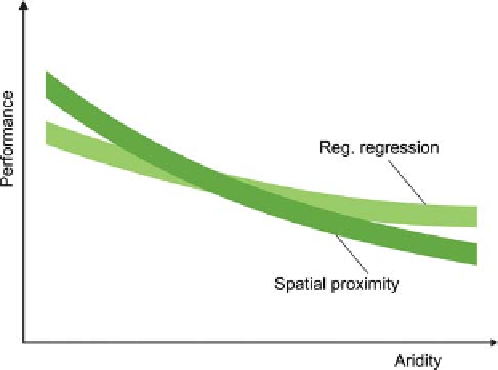Geography Reference
In-Depth Information
methods may work better in another climate. From the L2
assessment, for most of the signatures, there are indeed
clear differences between catchments in arid and humid
climates (see
Tables 12.2
and
12.3
). Annual runoff in
humid climates tends to be better predicted by the Budyko
(index) method than by regression, while the converse is
true of arid catchments. This may be because local soil
characteristics and vegetation patterns may be more
important in arid catchments than climate, and regression
methods can better accommodate this. Similarly, seasonal
runoff in humid climates tends to be better predicted by
spatial proximity methods than by regressions, while the
converse is true of arid catchments. Because humid catch-
ments tend to be more spatially homogeneous than arid
catchments, spatial proximity may be a better indicator of
similarity. In humid climates, low flows tend to be better
predicted in the presence of short records, while this is not
the case in arid regions. This is because climate tends to be
less variable in humid regions and short runoff records
may be more representative of the runoff variability, while
for arid regions this is not the case. In the case of floods,
the index method does not work well in arid regions.
Again, this may be related to the relatively much larger
spatial heterogeneity, which makes the assumption of
spatially uniform growth curves less suitable. In humid
regions, hydrographs are predicted well by spatial proxim-
ity methods, but in arid regions the performance of the
spatial proximity methods is much lower, again pointing
towards the differences in spatial hydrological heterogen-
eity between humid and arid regions.
Overall, in humid regions, there is a tendency for
proximity-based methods to work better than regression.
In contrast, regression tends to work better than spatial
proximity methods in arid regions. This is illustrated in
Figure 12.8
. This pattern should be expected, because arid
regions tend to be spatially more heterogeneous, as illus-
trated in
Figure 12.7b
. It should be emphasised, however,
that these are schematic trends, and for individual case
studies one would expect a lot of variation about these
trend lines.
Figure 12.8. Schematic of how performance of predicting runoff
signatures decreases with decreasing aridity for different
regionalisation methods based on the assessment in this topic.
of the effect of data availability on the predictive perform-
ance. The fact that consistent patterns were obtained by
comparing a large number of catchments in different con-
tinents suggests that the comparative hydrology approach
can be profitably used for generalising findings beyond
individual case studies.
12.3 Synthesis of Newtonian and Darwinian
frameworks
12.3.1 Evidence for co-evolution
Why is it that some methods work better in some places, and
not in others? As anticipated in
Chapter 2
, this topic advances
the idea of catchments as
'
organisms
'
, and advocates that
they be studied as
. The idea of catchments
as organisms that have reached their current state through
co-evolution naturally points towards the notion of emergent
patterns, at the catchment scale, which reflect the history of
co-evolution and provide insights into or reflect catchment
scale responses, as manifested in the runoff signatures. The
implications for predictions, in a geomorphological context,
has been brilliantly expressed by Haff (
1996
), who noted:
'
complex systems
'
Patterns from comparative hydrology
The comparative assessment has shown distinctive patterns
of runoff prediction performance as a function of processes,
places and scales. The comparison revealed consistent
patterns of the relative performance of predictions of
different runoff signatures across the Level 1 and Level 2
assessments. The comparison also showed that, for all
runoff signatures, there are clear dependencies of the
performance on aridity. The patterns were more complex
for air temperature and catchment elevation but could be
interpreted in the context of the hydrological processes.
Furthermore, the comparison provided consistent results
In large geomorphic systems, the construction of successful
predictive models is likely to be based upon discovery of emergent
variables and a corresponding dynamics, rather than upon scaling
up the results of well-controlled laboratory-scale studies;
a notion also discussed by Harrison (
2001
) and others.
Indeed, unlike in hydrology, there is in fact a long tradition
of recognising co-evolution and applying comparative
approaches in a number of earth sciences such as geo-
morphology and pedology, as also illustrated by the soil
catena concept of Jenny
(1980)
, for example. In hydrology,

Search WWH ::

Custom Search